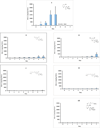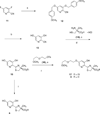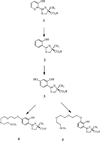Substituent effects on desferrithiocin and desferrithiocin analogue iron-clearing and toxicity profiles
- PMID: 22889170
- PMCID: PMC3583384
- DOI: 10.1021/jm300509y
Substituent effects on desferrithiocin and desferrithiocin analogue iron-clearing and toxicity profiles
Abstract
Desferrithiocin (DFT, 1) is a very efficient iron chelator when given orally. However, it is severely nephrotoxic. Structure-activity studies with 1 demonstrated that removal of the aromatic nitrogen to provide desazadesferrithiocin (DADFT, 2) and introduction of either a hydroxyl group or a polyether fragment onto the aromatic ring resulted in orally active iron chelators that were much less toxic than 1. The purpose of the current study was to determine if a comparable reduction in renal toxicity could be achieved by performing the same structural manipulations on 1 itself. Accordingly, three DFT analogues were synthesized. The iron-clearing efficiency and ferrokinetics were evaluated in rats and primates; toxicity assessments were carried out in rodents. The resulting DFT ligands demonstrated a reduction in toxicity that was equivalent to that of the DADFT analogues and presented with excellent iron-clearing properties.
Figures







Similar articles
-
The impact of polyether chain length on the iron clearing efficiency and physiochemical properties of desferrithiocin analogues.J Med Chem. 2010 Apr 8;53(7):2843-53. doi: 10.1021/jm9018146. J Med Chem. 2010. PMID: 20232803 Free PMC article.
-
Structure-activity relationships among desazadesferrithiocin analogues.Adv Exp Med Biol. 2002;509:167-84. doi: 10.1007/978-1-4615-0593-8_9. Adv Exp Med Biol. 2002. PMID: 12572994 Review.
-
Effects of C-4 stereochemistry and C-4' hydroxylation on the iron clearing efficiency and toxicity of desferrithiocin analogues.J Med Chem. 1999 Jul 1;42(13):2432-40. doi: 10.1021/jm990058s. J Med Chem. 1999. PMID: 10395484
-
Evaluation of the desferrithiocin pharmacophore as a vector for hydroxamates.J Med Chem. 1999 Jul 29;42(15):2881-6. doi: 10.1021/jm980611q. J Med Chem. 1999. PMID: 10425097
-
Development of tridentate iron chelators: from desferrithiocin to ICL670.Curr Med Chem. 2003 Jun;10(12):1065-76. doi: 10.2174/0929867033457610. Curr Med Chem. 2003. PMID: 12678677 Review.
Cited by
-
Desferrithiocin: a search for clinically effective iron chelators.J Med Chem. 2014 Nov 26;57(22):9259-91. doi: 10.1021/jm500828f. Epub 2014 Sep 10. J Med Chem. 2014. PMID: 25207964 Free PMC article. Review.
-
Growth Inhibition of a Novel Iron Chelator, DpdtC, against Hepatoma Carcinoma Cell Lines Partly Attributed to Ferritinophagy-Mediated Lysosomal ROS Generation.Oxid Med Cell Longev. 2018 Aug 5;2018:4928703. doi: 10.1155/2018/4928703. eCollection 2018. Oxid Med Cell Longev. 2018. PMID: 30154950 Free PMC article.
References
-
- Byers BR, Arceneaux JE. Microbial Iron Transport: Iron Acquisition by Pathogenic Microorganisms. Met. Ions Biol. Syst. 1998;35:37–66. - PubMed
-
- Bergeron RJ. Iron: A Controlling Micronutrient in Proliferative Processes. Trends Biochem. Sci. 1986;11:133–136.
-
- Theil EC, Huynh BH. Ferritin Mineralization: Ferroxidation and Beyond. J. Inorg. Biochem. 1997;67:30.
-
- Ponka P, Beaumont C, Richardson DR. Function and Regulation of Transferrin and Ferritin. Semin. Hematol. 1998;35:35–54. - PubMed
Publication types
MeSH terms
Substances
Grants and funding
LinkOut - more resources
Full Text Sources
Other Literature Sources

